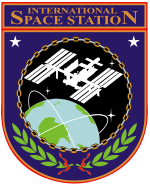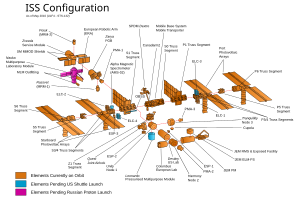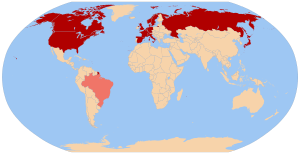国际空间站
 | |
 国际空间站臂章 | |
| 空间站信息 | |
|---|---|
| COSPAR ID | 1998-067A |
| 呼号 | Alpha |
| 成员数量 | 6人 |
| 发射日期 | 1998年—2011年 |
| 发射台 | 肯尼迪LC-39 拜科努尔LC-1/5和LC-81/23 |
| 质量 | 369,914 公斤 (815,520 磅) |
| 长度 | 51 米 (167.3 英尺) |
| 宽度 | 109 米 (357.5 英尺) |
| 高度 | c. 20 米 (c. 66 英尺) |
| 加压体积 | 837立方米 |
| 大气压力 | 101.3 千帕 |
| 远地点 | 360 公里 平均海拔 (2010年6月18日) |
| 近地点 | 347 公里 平均海拔 (2010年6月18日) |
| 轨道倾角 | 51.6 度 |
| 平均速度 | 7,706.6 米/秒 (27,743.8 公里/小时 |
| 轨道周期 | 91 分 |
| 在轨天数 | 9504 (November 27) |
| 有人天数 | 8793 (November 27) |
| 轨道数目 | 149180 (November 27) |
| 轨道衰减 | 2 公里/月 |
| 资料日期: 2010年5月23日 (除非另外注释) 参考资料: [1][2][3] | |
| 配置图 | |
 国际空间站装配状况 (至2010年5月18日为止) | |

国际空间站,是一个正在低地球轨道建造的国际研究设施,计划由六个国际太空机构合作联合推进,这六个机构分别是:美国国家航空航天局(NASA)、俄罗斯联邦航天局、日本宇宙航空研究开发机构、加拿大航天局、巴西航天局、欧洲空间局(欧洲空间局的成员国英国、爱尔兰、葡萄牙、奥地利和芬兰没有参加国际空间站计划,希腊和卢森堡则是在计划开始之后加入欧洲空间局的。[4])此外,中国也表达了参与该计划的意向,尤其是期望能与俄罗斯联邦航天局合作。[5][6]
从1998年11月20日国际空间站第一个部件曙光号功能货舱发射升空到2010年6月空间站已经在轨道上环绕地球运转了66000圈。预计国际空间站将于2011年全面落成,并会运作至2015年,甚至2020年或以后。[7]国际空间站的主要功能是作为在微重力环境下的研究实验室,研究领域包括生物学、人类生物学、物理学、天文学、地理学等。自从2000年11月2日之后,国际空间站上就保持至少两名乘员至今。
国际空间站运行于距离地面360公里的地球轨道上,由于大气阻力和重新启动等因素的影响,空间站的实际高度会发生数公里的漂移。空间站运行的这一类型的轨道叫做近地轨道。
最初负责国际空间站与地面之间运输的是航天飞机、联盟号飞船和进步号货运飞船。目前国际空间站仍在建设之中,最多可以承载六名乘员,大部分实验设施也已经投入使用。迄今为止登上国际空间站执行任务的宇航员均来自美国和俄罗斯的宇航计划,此外也有来自其他国家的宇航员到访国际空间站,其中还包括五名太空游客。
命名
编辑现在的名字“国际空间站”(英语:International Space Station, ISS;[Междунаро́дная косми́ческая ста́нция, МКС] 错误:{{Lang-xx}}:文本有斜体标记(帮助))是不同命名之间妥协的产物。国际空间站最初提议的名字是“阿尔法空间站”(Alpha),但是遭到俄罗斯的反对,俄方认为这样的命名暗示国际空间站是人类历史上第一个空间站,可是事实上苏联以及后来的俄罗斯先后成功地运行过8个空间站。俄罗斯提议将空间站命名为亚特兰大(英文:Atlanta[来源请求]),但是这个议案遭到美国的反对,美方认为亚特兰大的读音和拼写太接近传说中沉没的大陆“亚特兰蒂斯”,其中似乎隐含了不祥的征兆,而且亚特兰大这个名字也容易与美国的一架航天飞机——亚特兰提斯号航天飞机相混淆。[来源请求] }} 虽然国际空间站的命名没有采用最初提出的阿尔法空间站,但是空间站的无线电呼号却是阿尔法(Alpha),这个呼号是空间站第一批乘员登站时确定的,当时国际空间站的名字仍然未定,时任NASA主席的丹尼尔·戈登(Daniel S. Goldin)便给空间站取了一个临时呼号阿尔法,这个呼号最后沿用下来,成为空间站的正式电台呼号。
历史
编辑国际空间站计划的前身是美国国家航空航天局的自由空间站计划,这个计划是1980年代美国战略防御计划计划的一个组成部分。在1987年12月1日NASA宣布波音公司、通用电气公司、麦道飞机公司和洛迪恩推进动力公司获得了参与建造空间站的订单。老布什执政期间,星球大战计划被搁置,自由空间站也随之陷入停顿,1993年时任美国总统的比尔·克林顿正式结束了自由空间站计划。冷战结束后在美国副总统戈尔的推动下,自由空间站重获新生,NASA开始与俄罗斯联邦航天局接触,商谈合作建立空间站的构想。
1998年11月国际空间站的第一个组建曙光号功能货舱进入预定轨道,同年12月,由美国制造的团结号节点舱升空并与曙光号连接,2000年7月星辰号服务舱与空间站连接。2000年11月2日首批宇航员登上国际空间站。
空间站的各个组件大多由NASA的航天飞机进行运输,由于各个组件大多在地面就已经完成建设任务,宇航员在太空只需要进行很少的操作便可以将组件连接上空间站主体。到目前为止国际空间站的装配完成了一半,能够支持3名宇航员,到国际空间站完全完成之后,根据其设计共可以提供7名宇航员同时工作和生活。
国际空间站的预算远远超过了NASA最初的预计,其建造时间表也比预定的要晚,主要原因就是2003年初发生的哥伦比亚号航天飞机失事事件之后,美国宇航局停飞了所有的航天飞机。在航天飞机停飞的两年半时间里,空间站的人员和物资运输完全依赖俄罗斯的联盟号飞船,空间站上的科学研究活动也尽可能地被压缩了。 按照预定计划,空间站的建设将在航天飞机重返太空之后在2006年恢复,但是在2005年7月发现号航天飞机的STS-114飞行任务完成后,由于航天飞机隔热材料在升空过程中脱落,NASA再次停飞所有航天飞机,这使得国际空间站的建设时间表再次拖延。
模板参数错误!(代码34)
|
2006年11月15日,国际空间站上的活动首次在地球上进行了高清晰度电视直播,并在纽约的时代广场大屏幕电视上播放。这是人类首次观看到来自太空的高清晰度电视直播画面。直播节目的主角是国际空间站第14长期考察组指令长迈克尔·洛佩斯-阿莱格里亚,摄像师是站内的随航工程师托马斯·赖特尔。这套直播系统名为太空视频网关,直播的清晰度可以达到普通模拟视频的6倍。[1]
2007年1月31日,国际空间站第14长期考察组中的两名美国宇航员洛佩斯-阿莱格里亚和苏尼特·威廉斯成功进行超过7个小时的太空行走。他们将命运号实验舱的一个冷却回路从临时系统接入永久系统,完成了一些电路接线工作,使对接的航天飞机能接入并使用站上新太阳能电池板提供的电力,将一个遮光反射罩和隔热罩丢弃掉,然后将一组旧太阳能电池板上的散热器回收。[8]2月4日美国东部时间上午8时38分,这两名宇航员再度出舱,进行约7个小时的太空行走。他们将命运号实验舱的另一个冷却回路从临时系统接入永久系统,对一个废弃的氨水冷却设备进行清理。[9]2月8日,这两名宇航员完成了6小时40分钟的第三次太空行走,将空间站外的两个大型遮蔽罩移除丢弃,并安装货物运输机的几个附属装置。[10] 2月22日,国际空间站飞行工程师、俄罗斯宇航员米哈伊尔·秋林和洛佩斯-阿莱格里亚进行一次6个多小时的计划外太空行走,修复了对接在空间站上的进步M-58飞船的一处未能收拢的天线。[11]
2007年10月30日,[12]美国“发现号”航天飞机号太空人日前为国际空间站重新装配太阳能天线电池板时,电池板出现破裂,美国国家航空暨太空总署(NASA)科学家检视电池板破损处,了解造成原因。
2009年3月,NASA网站开始在线直播国际空间站实时视频,空间站工作人员睡觉或者下班的时候,全球互联网用户可以通过网络欣赏空间站的直播视频[13]。
建造计划
编辑按照计划,建造整个国际空间站共需要超过50次太空飞行和组装,其中的39次飞行需要由航天飞机完成,有大约30次飞行和装配任务需要进步号飞船提供支持。整个建造工作完成后,国际空间站将会有1200立方米的内部空间,总重量419000公斤,总输出功率达到110千瓦,衍架长度108.4米,舱体长度74米,额定乘员6人。
整个空间站由众多组件构成:
| 组件 | 航次 | 运载者 | 发射时间 | 长度 (m) |
直径 (m) |
质量 (kg) |
|---|---|---|---|---|---|---|
| 曙光号功能货舱 | 1 A/R | 质子号 | 1998年11月20日 | 12.6 | 4.1 | 19,323 |
| 团结号节点舱 (1号节点舱) | 2A - STS-88 | 奋进号 | 1998年12月4日 | 5.49 | 4.57 | 11,612 |
| 星辰号服务舱 | 1R | 质子号 | 2000年7月12日 | 13.1 | 4.15 | 19,050 |
| 国际空间站衍架 - Z1 衍架 | 3A - STS-92 | 发现号 | 2000年10月11日 | 4.9 | 4.2 | 8,755 |
| 国际空间站衍架 - P6 衍架及太阳能电池板 | 4A - STS-97 | 奋进号 | 2000年11月30日 | 73.2 | 10.7 | 15,824 |
| 命运号实验舱 | 5A - STS-98 | 亚特兰蒂斯号 | 2001年2月7日 | 8.53 | 4.27 | 14,515 |
| 外部装载平台1(ESP-1) | 5A.1 - STS-102 | 亚特兰蒂斯号 | 2001年3月13日 | 4.9 | 3.65 | 2,676 |
| 移动维修系统 - 空间站遥控机械臂(加拿大臂2) | 6A - STS-100 | 奋进号 | 2001年4月19日 | 17.6 | 0.35 | 4,899 |
| 寻求号气密舱(联合气密舱) | 7A - STS-104 | 亚特兰蒂斯号 | 2001年7月12日 | 5.5 | 4 | 6,064 |
| 码头号对接舱 - 码头号气密及对接舱 | 4R - 进步-M-SO1 | 进步号 | 2001年9月14日 | 4.9 | 2.3 | 3,676 |
| 国际空间站衍架 - S0衍架 | 8A - STS-110 | 亚特兰蒂斯号 | 2002年4月8日 | 13.4 | 4.6 | 13,971 |
| 移动维修系统 - 机械臂移动平台 | UF-2 - STS-111 | 奋进号 | 2002年6月5日 | 5.7 | 2.9 | 1,450 |
| 国际空间站衍架 - S1衍架 | 9A - STS-112 | 亚特兰蒂斯号 | 2002年10月7日 | 13.7 | 4.6 | 14,124 |
| 国际空间站衍架 - P1衍架 | 11A - STS-113 | 奋进号 | 2002年11月23日 | 13.7 | 4.6 | 14,003 |
| 外部装载平台2(ESP-2) | LF1 - STS-114 | 发现号 | 2005年7月26日 | 4.9 | 3.65 | 2,676 |
| 国际空间站衍架 - P3、P4衍架及太阳能电池板 | 12A - STS-115 | 亚特兰提斯号 | 2006年9月9日 | 13.8 | 4.8 | 15,824 |
| 国际空间站衍架 - P5衍架 | 12A.1 - STS-116 | 发现号 | 2006年12月9日 | 3.4 | 4.6 | 1,864 |
| 国际空间站衍架 - S3、S4衍架及太阳能电池板 | 13A - STS-117 | 亚特兰提斯号 | 2007年6月8日 | 13.7 | 5.0 | 16,183 |
| 国际空间站衍架 - S5衍架 | 13A.1 - STS-118 | 奋进号 | 2007年8月8日 | 3.4 | 4.6 | 1,864 |
| 外部装载平台3(ESP-3) | 13A.1 - STS-118 | 奋进号 | 2007年8月8日 | 4.9 | 3.65 | 2,676 |
| 和谐号节点舱 (2号节点舱) | 10A - STS-120 | 亚特兰提斯号 | 2007年10月23日 | 7.2 | 4.4 | 14,288 |
| 哥伦布实验舱 | 1E - STS-122 | 亚特兰提斯号 | 2008年2月7日 | 6.9 | 4.5 | 19,300 |
| 希望号日本实验舱 - 实验储藏舱 | 1J/A - STS-123 | 奋进号 | 2008年3月11日 | 3.9 | 4.4 | 4,200 |
| 移动维修系统 - 特殊微动作机械手 | 1J/A - STS-123 | 奋进号 | 2008年3月11日 | 3.67 | 6.70 | 1,560 |
| 希望号日本实验舱 | 1J - STS-124 | 发现号 | 2008年5月31日 | 11.19 | 4.39 | 14,800 |
| 希望号日本实验舱 - 日本机械臂 | 1J - STS-124 | 发现号 | 2008年5月31日 | 10.0 | 0.35 | 780 |
| 国际空间站衍架 - S6衍架及太阳能电池板 | 15A - STS-119 | 发现号 | 2009年3月15日 | 13.84 | 4.97 | 14,100 |
| 希望号日本实验舱 - 外部实验平台 | 2J/A - STS-127 | 奋进号 | 2009年7月15日 | 5.20 | 5.00 | 4,100 |
| 迷你研究舱2 (探索号迷你研究舱) | 5R - 进步-M-MIM2 | 进步号 | 2009年11月10日 | 2.25 | 4.049 | 3,670 |
| 宁静号节点舱 (3号节点舱) | 20A - STS-130 | 奋进号 | 2010年2月8日 | 6.706 | 4.480 | 19,000 |
| 穹顶舱 | 20A - STS-130 | 奋进号 | 2010年2月8日 | 1.500 | 2.955 | 1,880 |
| 迷你研究舱1 (晨曦号迷你研究舱) | ULF4 - STS-132 | 亚特兰提斯号 | 2010年5月14日 | 6.00 | 2.35 | 8,015 |
周期性往返任务:
- 多用途物流舱 (MPLM)
预定运送的组件
(依照预计发射顺序排列)
已取消的组件
- 离心重力舱
- 对接货舱
- 多用途对接舱
- 生活舱
- 乘员逃生太空船
- 空间站推进舱
- 俄罗斯实验舱
- 临时控制舱
接驳太空船
此外还有很多非承重衍架用于支撑空间站巨大的太阳能电池板。
增压舱
编辑当完成时,国际空间站将会有十六个增压舱,总容量达1000立方米。其中包括实验室、对接舱、气密舱、节点舱与生活空间,其中十四个已经在轨道运行,另有两个正等候发射。所有舱段都由航天飞机,质子号运载火箭或联盟号运载火箭发射升空。[14]
| 舱段 | 建造任务 | 发射日期 | 运载火箭 | 贡献国家 | 图片 | |
|---|---|---|---|---|---|---|
| 曙光号功能货舱 | 1A/R | 1998 年11月20日 | 质子号运载火箭 | 俄罗斯 (建造及营运者) 美国(资助者) |
[15] | |
| 为国际空间站第一个舱段。曙光号在国际空间站建筑初期提供电源、储存空间、发动机与导航系统。现在曙光号主要作为杂物储存空间与燃料槽使用。 | ||||||
| 团结号节点舱 (1号节点舱) | 2A | 1998年12月4日 | 奋进号航天飞机, STS-88 | 美国 | [16] | |
| The first node module, connecting the American section of the station to the Russian section (via PMA-1), and providing berthing locations for the Z1 truss, Quest airlock, Destiny laboratory and Tranquillity node. | ||||||
| 星辰号服务舱 |
1R | 2000年7月12日 | 质子号运载火箭 | 俄罗斯 | [17] | |
| The station's service module, which provides the main living quarters for resident crews, environmental systems and attitude & orbit control. The module also provides docking locations for Soyuz spacecraft, Progress spacecraft and the Automated Transfer Vehicle, and its addition rendered the ISS permanently habitable for the first time. | ||||||
| 命运号实验舱 (美国实验舱) | 5A | 2001年2月7日 | 亚特兰提斯号航天飞机, STS-98 | 美国 | [18] | |
| The primary research facility for US payloads aboard the ISS, Destiny is intended for general experiments. The module houses 24 International Standard Payload Racks, some of which are used for environmental systems and crew daily living equipment, and features a 51-厘米(20-英寸) optically perfect window, the largest such window ever produced for use in space. Destiny also serves as the mounting point for most of the station's Integrated Truss Structure. | ||||||
| 寻求号气密舱 (联合气密舱) | 7A | 2001年7月12日 | 亚特兰提斯号航天飞机, STS-104 | 美国 | [19] | |
| The primary airlock for the ISS, Quest hosts spacewalks with both US EMU and Russian Orlan spacesuits. Quest consists of two segments; the equipment lock, that stores spacesuits and equipment, and the crew lock, from which astronauts can exit into space. | ||||||
| 码头号对接舱 | 4R | 2001年9月14日 | 联盟号运载火箭, 进步-M-SO1 | 俄罗斯 | [20] | |
| Pirs provides the ISS with additional docking ports for Soyuz and Progress spacecraft, and allows egress and ingress for spacewalks by cosmonauts using Russian Orlan spacesuits, in addition to providing storage space for these spacesuits. | ||||||
| 和谐号节点舱 (2号节点舱) | 10A | 2007年10月23日 | 发现号航天飞机, STS-120 | 欧洲 (建造者) 美国(营运者) |
[21] | |
| The second of the station's node modules, Harmony is the utility hub of the ISS. The module contains four racks that provide electrical power, bus electronic data, and acts as a central connecting point for several other components via its six Common Berthing Mechanisms (CBMs). The European Columbus and Japanese Kibō laboratories are permanently berthed to the module, and American Space Shuttle Orbiters dock with the ISS via PMA-2, attached to Harmony's forward port. In addition, the module serves as a berthing port for the Italian Multi-Purpose Logistics Modules during shuttle logistics flights. | ||||||
| 哥伦布实验舱 (欧洲实验舱) | 1E | 2008年2月7日 | 亚特兰提斯号航天飞机, STS-122 | 欧洲 | [22][23] | |
| The primary research facility for European payloads aboard the ISS, Columbus provides a generic laboratory as well as facilities specifically designed for biology, biomedical research and fluid physics. Several mounting locations are affixed to the exterior of the module, which provide power and data to external experiments such as the European Technology Exposure Facility (EuTEF), Solar Monitoring Observatory, Materials International Space Station Experiment, and Atomic Clock Ensemble in Space. A number of expansions are planned for the module to study quantum physics and cosmology. | ||||||
| 希望号日本实验舱实验储藏舱 | 1J/A | 2008年3月11日 | 奋进号航天飞机,STS-123 | 日本 | [24] | |
| Part of the Kibō Japanese Experiment Module laboratory, the ELM provides storage and transportation facilities to the laboratory with a pressurised section to serve internal payloads. | ||||||
| 希望号日本实验舱 | 1J | 2008年5月31日 | 发现号航天飞机, STS-124 | 日本 | [24][25] | |
| Part of the Kibō Japanese Experiment Module laboratory, the PM is the core module of Kibō to which the ELM and Exposed Facility are berthed. The laboratory is the largest single ISS module and contains a total of 23 racks, including 10 experiment racks. The module is used to carry out research in space medicine, biology, Earth observations, materials production, biotechnology, and communications research. The PM also serves as the mounting location for an external platform, the Exposed Facility (EF), that allows payloads to be directly exposed to the harsh space environment. The EF is serviced by the module's own robotic arm, the JEM–RMS, which is mounted on the PM. | ||||||
| 探索号迷你研究舱 (迷你研究舱2) | 5R | 2009年11月10日 | 联盟号运载火箭, 进步-M- MIM2 | 俄罗斯 | [26][27] | |
| One of the Russian ISS components, MRM2 will be used for docking of Soyuz and Progress ships, as an airlock for spacewalks and as an interface for scientific experiments. | ||||||
| 宁静号节点舱 (3号节点舱) | 20A | 2010年2月8日 | 奋进号航天飞机, STS-130 | 欧洲 (建造者) 美国(营运者) |
[28][29] | |
| The third and last of the station's US nodes, Tranquility contains an advanced life support system to recycle waste water for crew use and generate oxygen for the crew to breathe. The node also provides four berthing locations for more attached pressurised modules or crew transportation vehicles, in addition to the permanent berthing location for the station's Cupola. | ||||||
| 穹顶舱 | 20A | 2010年2月8日 | 奋进号航天飞机, STS-130 | 欧洲 (建造者) 美国(营运者) |
[30] | |
| The Cupola is an observatory module that provides ISS crew members with a direct view of robotic operations and docked spacecraft, as well as an observation point for watching the Earth. The module comes equipped with robotic workstations for operating the SSRMS and shutters to protect its windows from damage caused by micrometeorites. | ||||||
| 晨曦号迷你研究舱 (迷你研究舱1) | ULF4 | 2010年5月14日 | 亚特兰提斯号航天飞机, STS-132 | 俄罗斯 | [31] | |
| MRM1 is being used for docking and cargo storage aboard the station. | ||||||
正等候发射的舱段
编辑| 舱段 | 建造任务 | 发射日期 | 运载火箭 | 贡献国家 | 图片 | |
|---|---|---|---|---|---|---|
| 多用途增压舱 | ULF5 | 不早于2010年12月17日 | 发现号航天飞机, STS-133 | 意大利 (建造者) 美国(营运者) |
[32][33][34] | |
| The Leonardo PMM will house spare parts and supplies, allowing longer times between resupply missions and freeing space in other modules, particularly Columbus. The PMM was created by converting the Italian Leonardo Multi-Purpose Logistics Module into a module that could be permanently attached to the station. The arrival of the module will mark the completion of the US Orbital Segment. | ||||||
| 科学号多用途实验舱 | 3R | 不早于2012年8月 | 质子号运载火箭 | 俄罗斯 | [31][35] | |
| The MLM will be Russia's primary research module as part of the ISS and will be used for general microgravity experiments, docking, and cargo logistics. The module provides a crew work and rest area, and will be equipped with a backup attitude control system that can be used to control the station's attitude. Based on the current assembly schedule, the arrival of Nauka will complete construction of the Russian Orbital Segment and it will be the last major component added to the station. | ||||||
目标
编辑有很多对NASA持批评观点的人认为国际空间站计划是在浪费时间和金钱,并且抑制了其他更有意义的计划。持有这种观点的人列举,花费在国际空间站计划上的上千亿美元和近乎一代人的时间,可以用来实施无数的无人太空任务,或者将这些时间和金钱花在地球上的研究中,也要比国际空间站更有意义。
空间站的支持者认为对于空间站的批评是目光短浅而且带有欺骗性的,支持者认为花费在载人空间探索上的巨额经费同样会给地球上的每个人带来切实的好处。有评估指出,国际空间站计划所开发的载人航天相关技术的商业应用,会间接带动全球经济,其所带来的收益是最初投资的七倍,也有一些相对保守的估计则认为此种收益只是最初投资的三倍。还有一些坚定的支持者认为,即便国际空间站在科学方面的意义为零,仅其发挥的推动国际合作的作用,也足以令这个计划彪炳史册。
长期考察组
编辑所有永久驻地乘员组命名“长期考察组N”, “长期考察N”在每次长期考察以后连续地被增加。太空游客没有算作是长期考察成员。
直至2010年6月,共完成了23次长期考察(长期考察1-23),1次进行中(长期考察24),9次计划中(长期考察25-33)。
参考文献
编辑- ^ Chris Peat. ISS—Orbit Data. Heavens-Above.com. 18 June 2010 [18 June 2010].
- ^ Steven Siceloff. NASA Yields to Use of Alpha Name for Station. Florida Today. 1 February 2001 [18 January 2009].
- ^ STS-132 Press Kit (PDF). NASA. 7 May 2010 [19 June 2010].
- ^ European Space Agency http://www.esa.int/esaHS/partstates.html
- ^ China wants role in space station. CNN. Associated Press. October 16, 2007 [2008-03-20]. (原始内容存档于2008-03-14).
- ^ James Oberg. China takes aim at the space station. MSNBC. October 26, 2001 [2009-01-30].
- ^ Statement by Charlie Bolden, NASA Budget Press Conference (PDF) (新闻稿). NASA. 1 February 2010 [1 February 2010].
- ^ 张忠霞,国际空间站宇航员进行太空行走,新华网
- ^ 张忠霞,空间站宇航员完成第二次太空行走,新华网
- ^ 张忠霞,空间站宇航员太空行走创纪录,新华网
- ^ 刘洋,张忠霞,空间站宇航员太空行走 修复"进步"飞船天线故障,新华网
- ^ 国际空间站太阳电板破损 恐影响太空站用电
- ^ 孝文. NASA网站开始在线直播国际空间站实时视频. 科学网. 2009-3-14 [2009年3月14日] (中文(简体)).
- ^ HSF: ISS assembly sequence and on-orbit configuration. European Space Agency (ESA). [6 March 2009].
- ^ Zarya Module. NASA. 14 October 2008 [7 December 2009].
- ^ Unity Connecting Module: Cornerstone for a Home in Orbit (PDF). NASA. January 1999 [11 March 2009].
- ^ Zvezda Service Module. NASA. 11 March 2009 [11 March 2009].
- ^ NASA—US Destiny Laboratory. NASA. 26 March 2007 [26 June 2007].
- ^ Space Station Extravehicular Activity. NASA. 4 April 2004 [11 March 2009].
- ^ Pirs Docking Compartment. NASA. 10 May 2006 [28 March 2009].
- ^ Harmony Node 2. NASA. 26 September 2007 [28 March 2009].
- ^ Chris Bergin. PRCB plan STS-122 for NET Feb 7—three launches in 10–11 weeks. NASASpaceflight.com. 10 January 2008 [12 January 2008].
- ^ Columbus laboratory. European Space Agency (ESA). 10 January 2009 [6 March 2009].
- ^ 24.0 24.1 NASA—Kibo Japanese Experiment Module. NASA. 23 November 2007 [28 March 2009].
- ^ About Kibo. Japan Aerospace Exploration Agency (JAXA). 25 September 2008 [6 March 2009].
- ^ Anatoly Zak. Docking Compartment-1 and 2. RussianSpaceWeb.com. [26 March 2009].
- ^ Chris Bergin. Russian module launches via Soyuz for Thursday ISS docking. NASASpaceflight.com. 10 November 2009 [10 November 2009].
- ^ Robert Z. Pearlman. NASA Names Space Module After Moon Base, Not Stephen Colbert. Space.com. 15 April 2009 [15 April 2009].
- ^ Node 3: Connecting Module. European Space Agency (ESA). 23 February 2009 [28 March 2009].
- ^ Cupola. European Space Agency (ESA). 16 January 2009 [28 March 2009].
- ^ 31.0 31.1 引用错误:没有为名为
Manifest的参考文献提供内容 - ^ Chris Gebhardt. STS-133 refined to a five crew, one EVA mission—will leave MPLM on ISS. NASASpaceflight.com. 5 August 2009.
- ^ Amos, Jonathan. Europe looks to buy Soyuz craft. BBC News. 29 August 2009.
- ^ Shuttle Q&A Part 5. NASASpaceflight.com. 27 September 2009 [12 October 2009].
- ^ FGB-based Multipurpose Lab Module (MLM). Khrunichev State Research and Production Space Centre. [31 October 2008]. (原始内容存档于27 September 2007).